MENUMENU
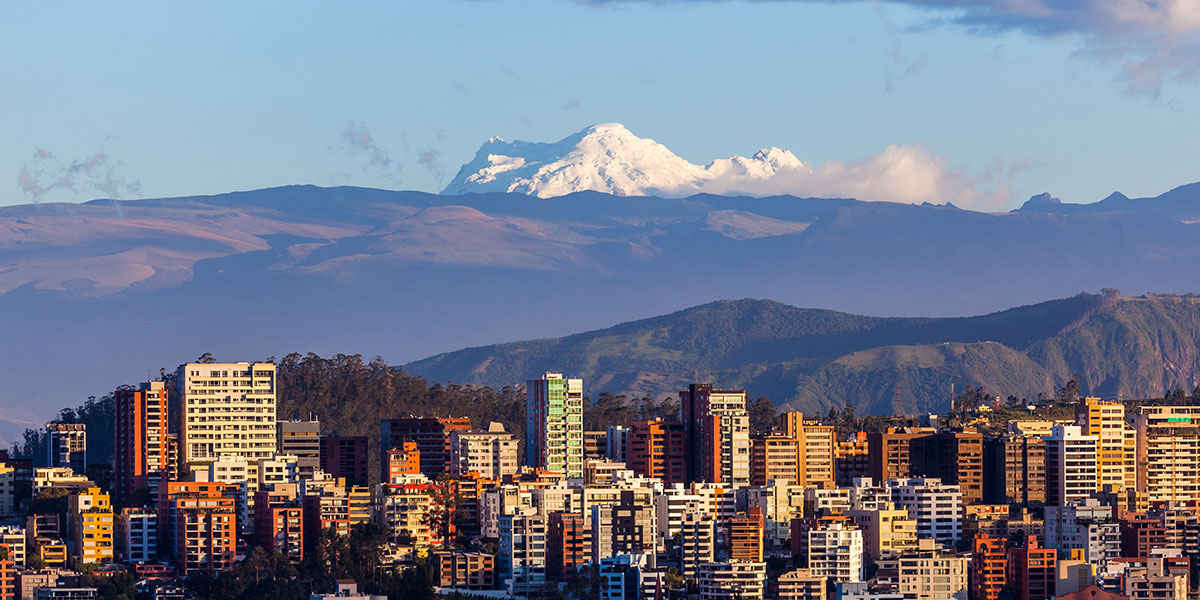
Reading time: 20 mins
South America is a paradise for adventure seekers and nature lovers. With its spectacular landscapes and diverse flora and fauna, it offers endless possibilities for hiking enthusiasts. More often than not, South America is often viewed as the coveted hiker’s dream destination. From the soaring peaks of the Andes to the ancient trails of the Inca civilization, it seems there’s a trek for just about everyone. In this blog, we’ll take you through the ten best hikes in South America that you won’t want to miss wandering down!
The Inca Trail is probably the most famous hike in South America, and for good reason. This trail leads you through a spectacular landscape surrounded by colossal Andean peaks, sweeping cloud forests, and enigmatic ancient ruins. The best part? The end of the trail rewards hikers with the legendary and jaw-dropping Machu Picchu—the crown jewel of ancient ruins.
Not only that but the Inca Trail is steeped in history, as it follows the very same path that the Incas created to get to the world-renowned archaeological site of Machu Picchu. By taking this top hike in South America, you’re literally treading in the Inca’s footsteps! Need we say more?

Inca trail landscape
Moderate to challenging. The Inca Trail involves steep inclines, rocky paths, and high altitudes. The trail’s highest point is Dead Woman’s Pass, standing at 13,779 feet (4,200 meters)—an altitude that may pose a challenge due to thinner air and potential altitude sickness. Weather conditions, too, can be unpredictable in the Andes, so it’s important to be prepared for rain, mud, or even snow, which can impact the duration of your hike.
The duration of this hike can vary depending on how much you customize it and/or the weather conditions. Typical hikes last approximately four days, covering around 26 miles (42 km) from their usual starting point in the Sacred Valley. For those seeking a less challenging option, the Short Inca Trail is a fantastic choice, lasting only two days.
Yes, a guide (and oftentimes even a porter to carry heavy gear, food, etc.) is required. Bear in mind that permits for the Inca Trail are limited, often selling out several months in advance. Why the permits, you ask? This Peruvian regulation helps preserve the trail and the Machu Picchu site, ensuring that the impact of tourism is controlled and that the paths stay protected.
Torres del Paine, located in the southern Chilean Patagonia, is a spectacular national park that offers some of the most breathtaking scenery on the planet. Known for its towering mountains, bright blue icebergs, and grasslands, the Torres del Paine National Park is an absolute marvel for trekkers and nature lovers alike. The park’s most iconic features are the three granite towers, or “Torres,” from which it gets its name.
For those looking for a once-in-a-lifetime hiking experience, Torres del Paine’s treks offer the perfect blend of natural beauty, physical challenges, and the opportunity to experience absolute serenity in one of the most stunning settings on the planet.

Hiking experience in Torres del Paine
The difficulty of hiking in Torres del Paine can range from moderate to challenging, depending on the chosen trail. The W Trek is considered moderately challenging and can be completed in about 4-5 days, covering approximately 50 miles (80 kilometers). The O Circuit is more demanding, typically taking 6–10 days to complete and covering about 80 miles (130 kilometers).
The trails can involve long distances and steep ascents (and descents!), and trekkers must be prepared for the famously unpredictable Patagonian weather, which can change rapidly from sunshine to rain or wind.
While a guide is not mandatory for the W Trek or the O Circuit, it is highly recommended, especially for those not experienced in backcountry hiking or unfamiliar with rapidly changing mountain weather. There are also options for guided tours, including accommodation in refugios (lodges) or campsites. Reservations for campsites and entrance permits to the park should be made well in advance, especially during the high season (October to April), as they can sell out quickly. These regulations and booking procedures help manage the flow of visitors and minimize the environmental impact on this pristine wilderness.
Cotopaxi National Park is renowned for its stunning, high-altitude landscapes that are dominated by the epic Cotopaxi Volcano—one of the world’s highest active volcanoes. This park is a haven for adventurers and nature enthusiasts, offering a unique blend of ecological diversity, geological wonders, and cultural richness. The park’s diverse landscape includes vast plains, mountainous areas, and unique flora and fauna, making it a must-visit destination for those exploring the Andes.
The biggest attraction of Cotopaxi National Park is the challenge and thrill of climbing the Cotopaxi Volcano. Standing at an impressive 19,347 feet (5,897 meters), it offers one of the most exciting high-altitude climbs in the world. Hiking in Cotopaxi National Park provides a unique opportunity to experience the beauty of the Andean paramo (high-altitude grasslands) and to spot wildlife such as wild horses, llamas, and possibly even Andean condors. The park is also home to several other smaller volcanoes and peaks, offering various hiking and climbing options for different skill levels.
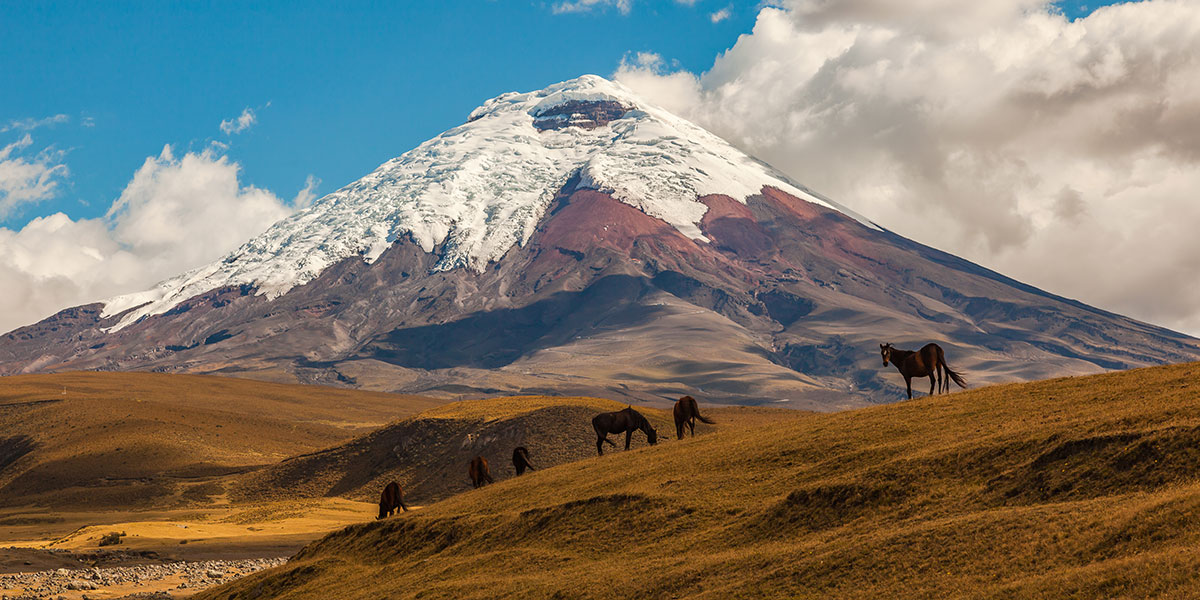
Cotopaxi National Park, Ecuador
The difficulty level of activities in Cotopaxi National Park varies. Hiking and trekking can range from easy to challenging, depending on the trail. Climbing the Cotopaxi Volcano is considered challenging due to its high altitude and requires good physical condition, acclimatization to the altitude, and, ideally, previous mountaineering experience.
The climb to the summit of Cotopaxi involves an overnight ascent, with a stay at the mountain refuge before heading out. Other hiking trails in the park can take anywhere from a few hours to a full day, depending on the route and pace.
For climbing Cotopaxi Volcano, a certified guide is required due to the technical nature of the climb and the risks associated with high-altitude mountaineering. For general hiking in the park, a guide is not mandatory but can enhance the experience by providing insights into the area’s natural and cultural history. Guides can also assist with navigation and offer safety tips for handling the park’s variable weather conditions.
It’s important to note that access to certain areas of the park, especially the summit of Cotopaxi, may be restricted due to volcanic activity or weather conditions. Visitors should check the latest park regulations and weather forecasts before planning their trip.
The Huayhuash Circuit, nestled in the Peruvian Andes, is a renowned trekking route known for its stunning natural beauty, remote wilderness, and challenging terrain. This circuit winds through the Cordillera Huayhuash range, offering breathtaking views of jagged mountain peaks, crystal-clear glacial lakes, and pristine high-altitude landscapes. It’s a favorite among seasoned trekkers and those seeking a truly off-the-beaten-path adventure in one of the most spectacular settings in South America.
This circuit is celebrated for its unparalleled mountain scenery, encompassing some of the most dramatic peaks in the Andes, including the gorgeous Yerupaja, the second-highest mountain range in Peru. Known for its relative solitude compared to more frequented trails like the Inca Trail. It offers a more authentic wilderness experience, with opportunities to encounter local Andean communities living in remote areas largely untouched by modern civilization.

Huayhuash Circuit Hike
The Huayhuash Circuit is considered challenging and is suitable for experienced hikers. The trek involves long days of walking, often at altitudes exceeding 13,123 feet (4,000 meters), with several high passes over 14,764 feet (4,500 meters). Acclimatization to high altitudes and good physical fitness are essential.
The standard circuit typically takes about 10 to 12 days to complete, covering a distance of approximately 81 miles (130 kilometers). Shorter variations are possible, but they miss some of the circuit’s highlights. The trek’s demanding nature is balanced by the breathtaking scenery and the sense of accomplishment in completing one of the world’s most stunning treks.
While it’s possible to trek the Huayhuash Circuit independently, hiring a guide or joining a guided tour is highly recommended, especially for those unfamiliar with high-altitude trekking or remote wilderness navigation. A guide can provide valuable knowledge of the route, weather conditions, and local culture.
Guides and tours can also arrange necessary logistics like transportation to the trailhead, food, and camping equipment, which can be challenging to organize independently. The remote nature of the circuit means that preparation and safety are paramount, and having an experienced guide enhances both the safety and enjoyment of the trek.
The Fitz Roy Trek, set in the spectacular Los Glaciares National Park in Argentinian Patagonia, is a world-renowned hike that’s celebrated for its awe-inspiring landscapes and majestic peak. This trek offers stunning views of Mount Fitz Roy, known locally as Cerro Fitz Roy, an iconic and stunning spire-shaped peak that is one of the most challenging mountains to climb globally. The surrounding area is a dramatic mix of rugged mountain terrain, pristine glacial lakes, and dense Patagonian forests, making it a paradise for hikers and nature enthusiasts.
As with many of the other top hikes in South America on this list, the Fitz Roy Trek is also distinguished by its breathtaking scenery, including some of the most picturesque and photographed vistas in Patagonia. The trek offers various routes, allowing hikers to witness other famous landmarks like Laguna de los Tres and Laguna Torre, both of which offer incredible close-up views of the Fitz Roy and Cerro Torre peaks, respectively.
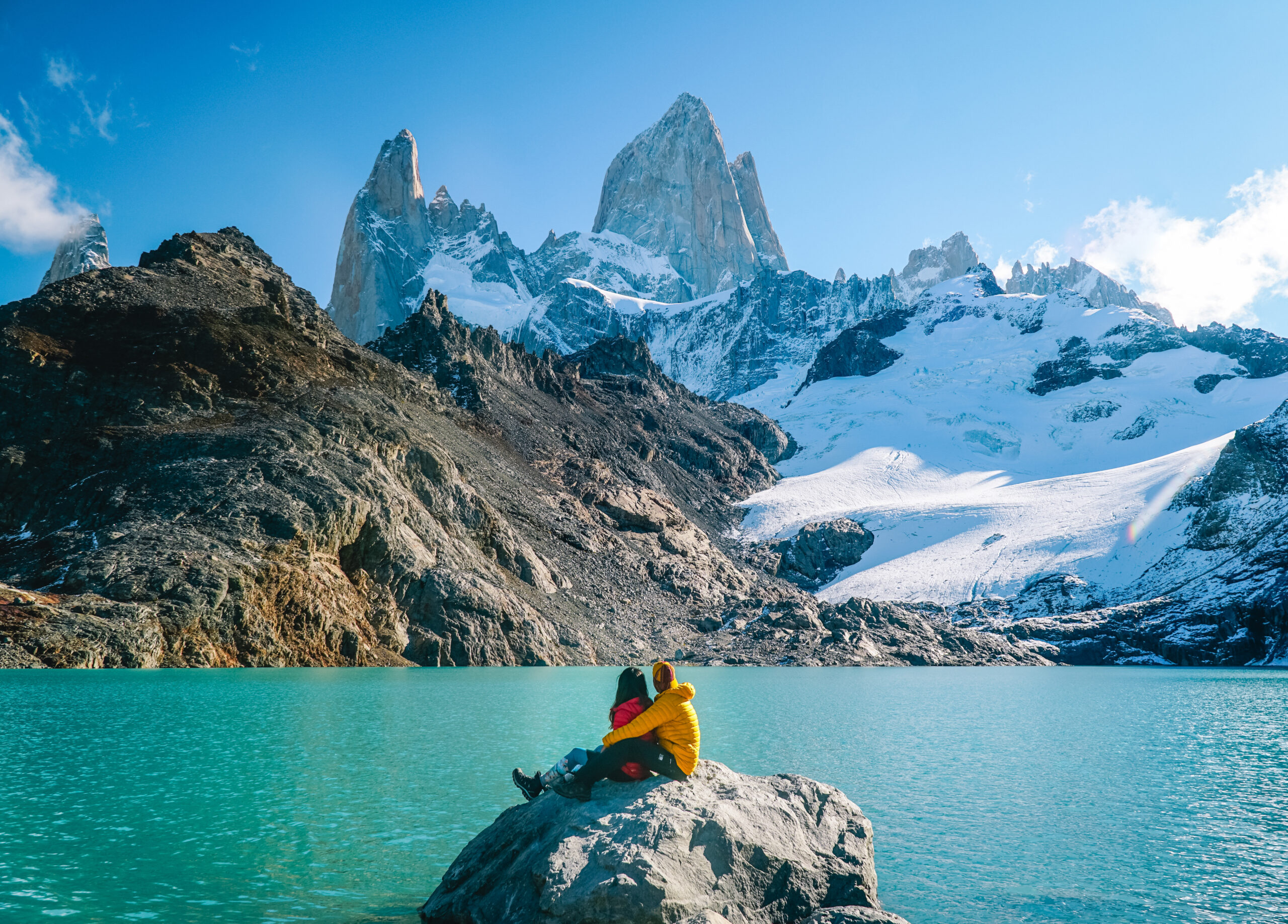
Los Glaciares National Park, Argentina
This hike is accessible to a wide range of hikers, from beginners to experienced adventurers, with various trails that vary in difficulty and length. The well-marked paths and the relatively lower altitudes (compared to other Andean treks) make it an excellent choice for those looking to experience the beauty of Patagonia without the challenges of high-altitude hiking.
The difficulty of the Fitz Roy Trek varies from moderate to challenging, depending on the specific trails and weather conditions. Some popular hikes, like the trek to Laguna de los Tres, can be completed as day hikes and are considered moderate, involving steady inclines and well-trodden paths. The duration of the hikes in the Fitz Roy area can range from a few hours to a full day. For those seeking a longer trekking experience, multi-day itineraries can combine several routes, offering a comprehensive exploration of the region.
A guide is optional for most trails in the Fitz Roy area, as the paths are generally well-marked and maintained. However, hiring a guide can enhance the experience by providing insights into the region’s unique flora, fauna, and geography. In addition, guided tours can offer logistical support, including transportation, meals, and equipment, which can be particularly beneficial for multi-day treks.
It’s important to be prepared for the unpredictable Patagonian weather, which can change rapidly and often includes strong winds, rain, and even snow. Proper planning, including checking weather forecasts and preparing appropriate gear, is essential for a safe and enjoyable trekking experience in this magnificent part of Argentina.
The Santa Cruz Trek, nestled in the heart of the Cordillera Blanca in Peru, is a mesmerizing journey through some of the most breathtaking landscapes in South America. This trek is a paradise for hikers, offering a stunning display of towering mountain peaks, vibrant blue glacial lakes, and sweeping valleys blanketed in lush vegetation. It’s a less-trodden path compared to the Inca Trail, but trust us when we say it’s just as captivating.
The Santa Cruz Trek stands out for its raw, untouched natural beauty. Home to some of the highest tropical mountains in the world, including the stunning Alpamayo, often referred to as the most beautiful mountain on Earth. The trek is not just a physical journey; it’s a feast for the eyes and the soul. As you make your way through the trek, you’ll pass through quaint Andean villages, giving you a glimpse into the rural life of Peru.

Santa Cruz Trek landscape
The Santa Cruz Trek is considered moderate in difficulty. It’s more accessible than the challenging Inca Trail, making it a great option for those who want a high-altitude experience without certain extremes. The trek’s highest point is Punta Union Pass, which is found at an elevation of 15,584 feet (4,750 meters). While less daunting than the Dead Woman’s Pass on the Inca Trail, the Santa Cruz Trek still requires acclimatization to handle the altitude.
Typically, the trek spans four days, covering a distance of about 31 miles (50 km). This makes it a perfect choice for those with limited time but still want a fulfilling trekking experience in the Andes. The trek is a loop, starting and ending in the town of Huaraz, a hub for trekkers and adventurers.
While a guide is not mandatory for the Santa Cruz Trek as it is for the Inca Trail, it’s highly recommended. A guide can enrich your experience by providing insights into the local flora, fauna, and culture. Also, they can help navigate the occasionally tricky paths and changing weather conditions. Unlike the Inca Trail, there are no permit requirements for the Santa Cruz Trek, making it more flexible for last-minute plans. However, it’s essential to be well-prepared with proper gear and acclimatization to ensure a safe and enjoyable trek.
The Lost City Trek, or “Ciudad Perdida” in Spanish, is a captivating journey deep into the dense jungles of the Sierra Nevada de Santa Marta in Colombia. As the name might imply, this trek is a hidden gem, offering a unique blend of adventure, ancient history, and cultural richness. Unlike the more famous trails like the Inca Trail to Machu Picchu, the Lost City Trek is a path less traveled, leading to one of the most significant archaeological sites in South America.
The highlight of the trek is the reward that one receives upon arriving at the Lost City—a mysterious archaeological site believed to have been founded around 800 AD, which is some 650 years earlier than Machu Picchu. The site consists of terraces carved into the mountainside, a network of tiled roads, and several small circular plazas. The journey to the Lost City is as remarkable as the destination itself. The trek meanders through the lush, biodiverse jungle of the Sierra Nevada, crossing rivers and offering glimpses of exotic wildlife and unique flora. Another great hiking spot is the Valle de Cocora, in the heart of Colombia’s coffee-growing region. It offers a memorable hiking experience with its unique landscapes and towering palm trees.
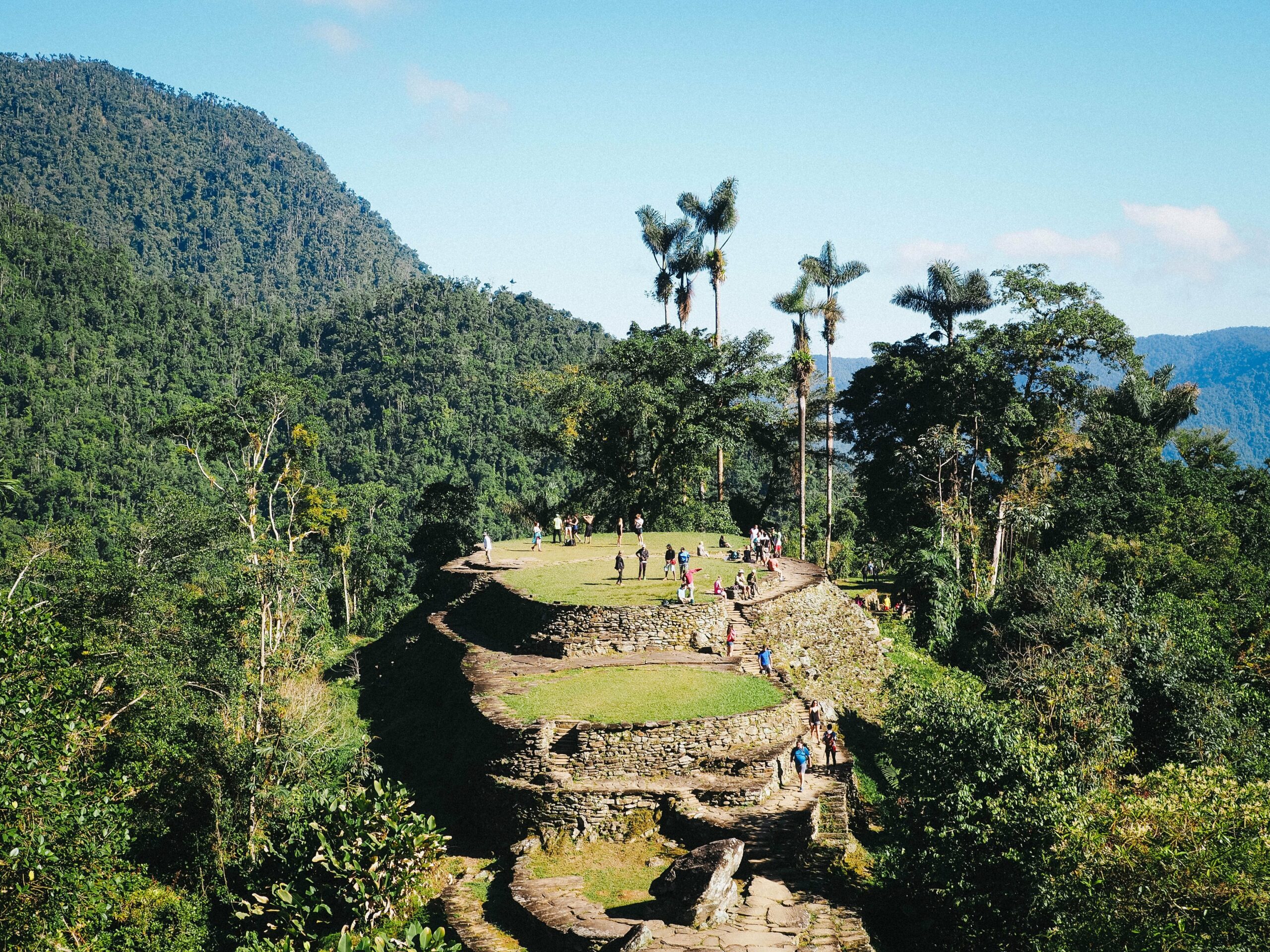
Lost City Trek in Santa Marta, Colombia
The Lost City Trek is generally considered challenging, mainly due to the humid and demanding jungle environment. The trek involves river crossings, steep climbs, and navigating through dense vegetation. However, it’s manageable for most people with a reasonable fitness level.
Typically, the trek takes 4 to 6 days, covering a total distance of approximately 27 miles (44 kilometers) round trip. The duration will usually depend on the pace and preference of the hiker, with various campsite options available along the route.
Yes, a guide is mandatory for the Lost City Trek. The trek is not only physically challenging but also involves navigating through remote and dense jungle terrain, where a guide is essential for safety and direction. Guides also offer valuable insights into the local indigenous communities, flora and fauna, and the history of the Lost City itself.
Unlike the regulated Inca Trail, the Lost City Trek does not require months-in-advance booking or permits, offering more flexibility. However, the remote nature of the trek and the importance of respecting the local indigenous communities and the natural environment make it essential to go with a registered tour company. The trek is a blend of adventure, cultural immersion, and historical exploration, making it a unique and unforgettable experience in South America.
The Rainbow Mountain Trek in Peru, also known as Vinicunca, is a visually stunning and physically exhilarating journey in the Andes. This hike in South America is renowned for leading to the Rainbow Mountain, a natural wonder known for its strikingly colorful mineral-rich sediments. Unlike the classic Inca Trail or the remote Santa Cruz Trek, Rainbow Mountain offers a unique geological spectacle and is rapidly becoming a definitive hike in Peru.
The trek is a journey through a beautiful and remote landscape characterized by traditional Andean villages, grazing llamas and alpacas, and panoramic views of the snow-capped Andes. The area is relatively untouched by modernity, offering a glimpse into the traditional lifestyle of the local Quechua people.
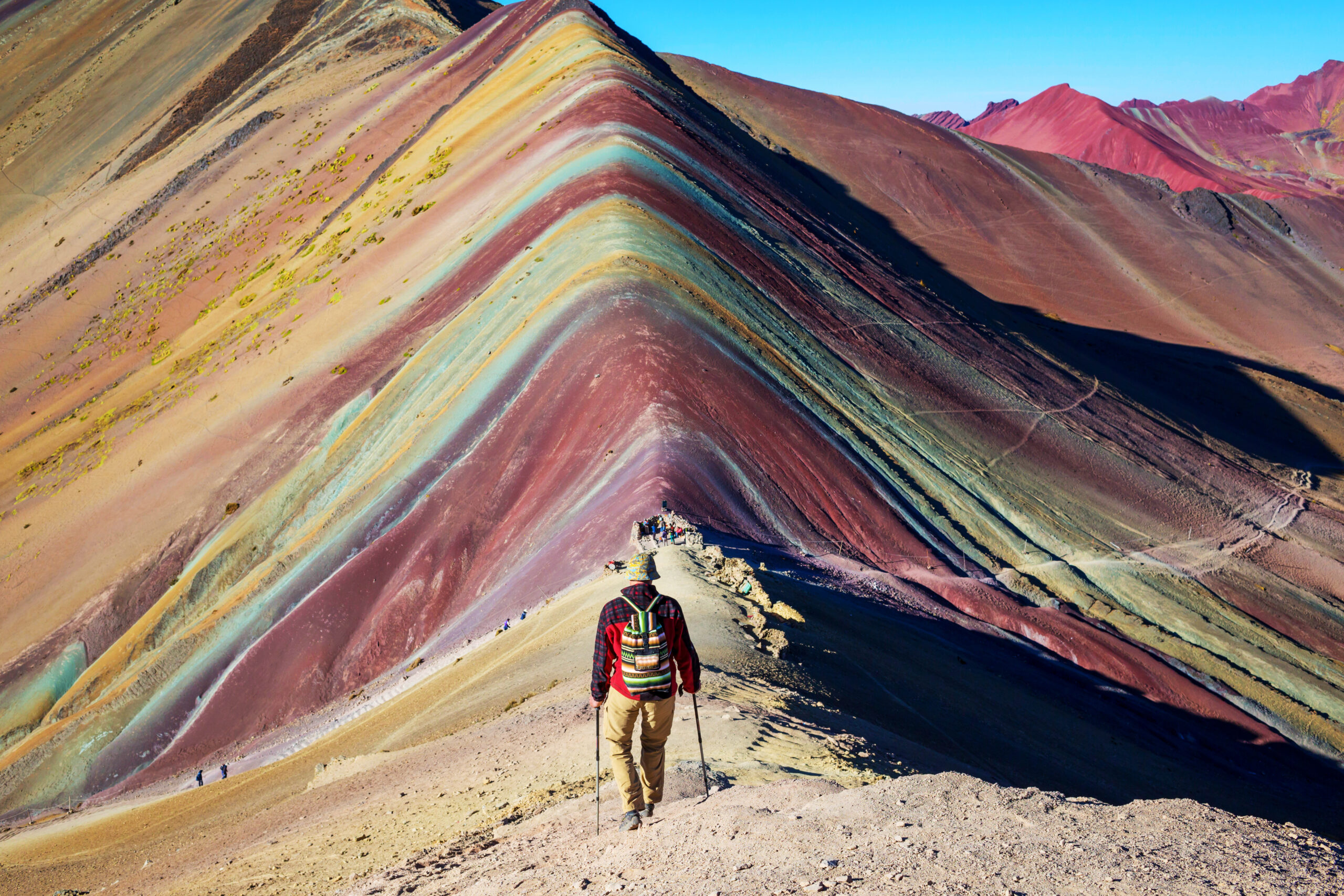
Rainbow Mountain Trek, Peru
The Rainbow Mountain Trek is considered challenging mainly due to its high altitude. The mountain’s peak is around 17,060 feet (5,200 meters) above sea level, making acclimatization a key factor for a successful trek. The trek can be strenuous for those not used to high altitudes, with thin air making breathing more difficult as you ascend.
The trek to Rainbow Mountain can be completed in a single day, making it a great option for those with limited time in Peru. The hike itself is about 8.7 miles (14 kilometers) roundtrip, starting and ending at the base camp. For those who prefer a less strenuous experience, there are options for multi-day treks that include Rainbow Mountain as part of a longer itinerary.
While a guide is not strictly required for the Rainbow Mountain Trek, it is highly recommended, especially for those unfamiliar with high-altitude trekking. A guide can provide valuable information about the terrain, weather conditions, and altitude sickness prevention. Additionally, going with a guide ensures that you are respectful of the local environment and communities, as this area is sacred to many Andean people.
Since the popularity of Rainbow Mountain has skyrocketed in recent years, it’s essential to be prepared for varying weather conditions and to start the trek early in the morning to avoid crowds. Despite the challenges, the unique beauty of Rainbow Mountain makes it a rewarding and unforgettable trek in the heart of the Peruvian Andes.
The Huayna Potosi Trek (more like a “climb,” really) in Bolivia is an awe-inspiring journey, often hailed as one of the most accessible ways to conquer a near 20,000-foot (6000-meter) peak in the Andes. Located just outside La Paz, Huayna Potosi is a majestic snow-capped mountain offering an unparalleled climbing experience. Unlike the more traditional treks like the Inca Trail or the Rainbow Mountain Trek, Huayna Potosi provides a unique opportunity for novice climbers to safely attempt a high-altitude climb.
Huayna Potosi is renowned for its stunning beauty and the exhilarating challenge it presents. The climb offers breathtaking views of the Cordillera Real mountain range and a sense of achievement that comes with reaching such an impressive altitude. Also, on a clear day, climbers can see the vast Altiplano, the sprawling city of La Paz, and the distant Lake Titicaca.
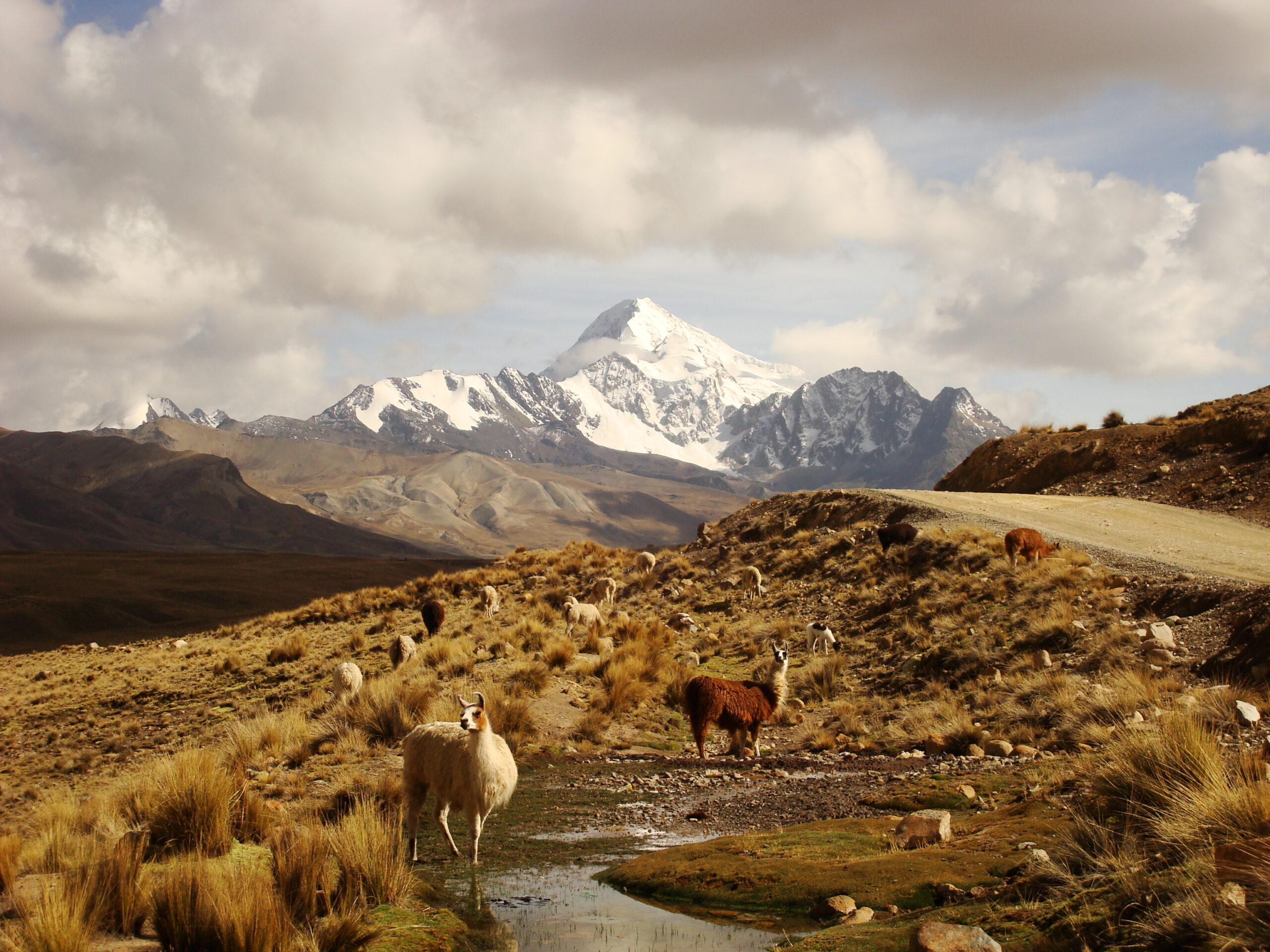
Huayna Potosi in Bolivia
Huayna Potosi is considered a moderately technical climb, suitable for those with little to no previous mountaineering experience but who are in good physical condition. The key challenges include dealing with the altitude and the icy conditions on the glacier.
The climb usually takes about 2 to 3 days. The first day often involves acclimatization and basic mountaineering training that focuses on using crampons and an ice axe. The subsequent days involve the ascent to the summit and the descent back to base camp. The highest point of Huayna Potosi is at 6,088 meters (19,974 feet), and the thin air at this altitude makes the climb more challenging.
Yes, a guide is essential for the Huayna Potosi climb. Given the technical nature of the ascent, especially the glacier traverse, having a skilled and experienced guide is crucial for safety. Guides provide the necessary equipment, training, and expertise in navigating the mountain’s terrain and rapidly changing weather conditions.
Climbing Huayna Potosi is an exceptional experience that combines physical challenges, stunning natural beauty, and the thrill of high-altitude mountaineering. It’s a perfect adventure for those looking to step beyond traditional trekking and experience the exhilaration of conquering a towering Andean peak.
The Colca Canyon trek in Peru is a captivating journey that takes you into one of the deepest canyons in the world, surpassing even the Grand Canyon in depth. Situated in southern Peru, Colca Canyon offers a breathtaking blend of natural beauty, rich cultural history, and unique wildlife. This trek is distinct from high-altitude climbs like Huayna Potosi or classic trails like the Inca Trail, as it goes deep into a gorgeous canyon adorned with ancient terraces and home to the magnificent Andean condors.
The trek into Colca Canyon is a plunge into a landscape brimming with history and culture. As you descend, you’ll get to marvel at how the canyon’s walls are lined with intricate pre-Incan agricultural terraces, still in use today, showcasing the engineering prowess of ancient civilizations. One of the major highlights of Colca Canyon is the chance to witness the Andean condors in flight.

Colca Canyon trek, Peru
The trek into Colca Canyon is considered moderately difficult. It involves descending into the canyon and then ascending back out, which can be physically demanding due to the steep inclines and the altitude at which it’s located. However, the paths are well-trodden and accessible.
The duration of the trek can vary, with options ranging from a single day to three days or more. The longer treks offer more time to explore the canyon’s depths, visit remote villages, and experience the tranquility of the area. The typical trek involves staying overnight in basic lodges or homestays, enhancing one’s cultural immersion in the destination.
A guide is not mandatory for the Colca Canyon trek, but having one is highly recommended. A knowledgeable guide enhances the experience by providing insights into the local culture, history, and environment. They can also assist with navigating the trails and handling logistics, such as accommodation and transport.
South America’s natural beauty, rich indigenous heritage, and vast wilderness attract countless hikers every year. With these ten best hikes in South America, you can experience the incredible natural diversity it holds and is waiting to share. From the Inca Trail in Peru to Cotopaxi National Park in Ecuador, you will have a unique opportunity to explore postcard-worthy landscapes that most people often only get to experience through pictures or videos on their phones! So, if you have an adventurous spirit and a thirst for venturing down these hiking gems, plan your hiking trip to South America today!